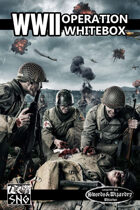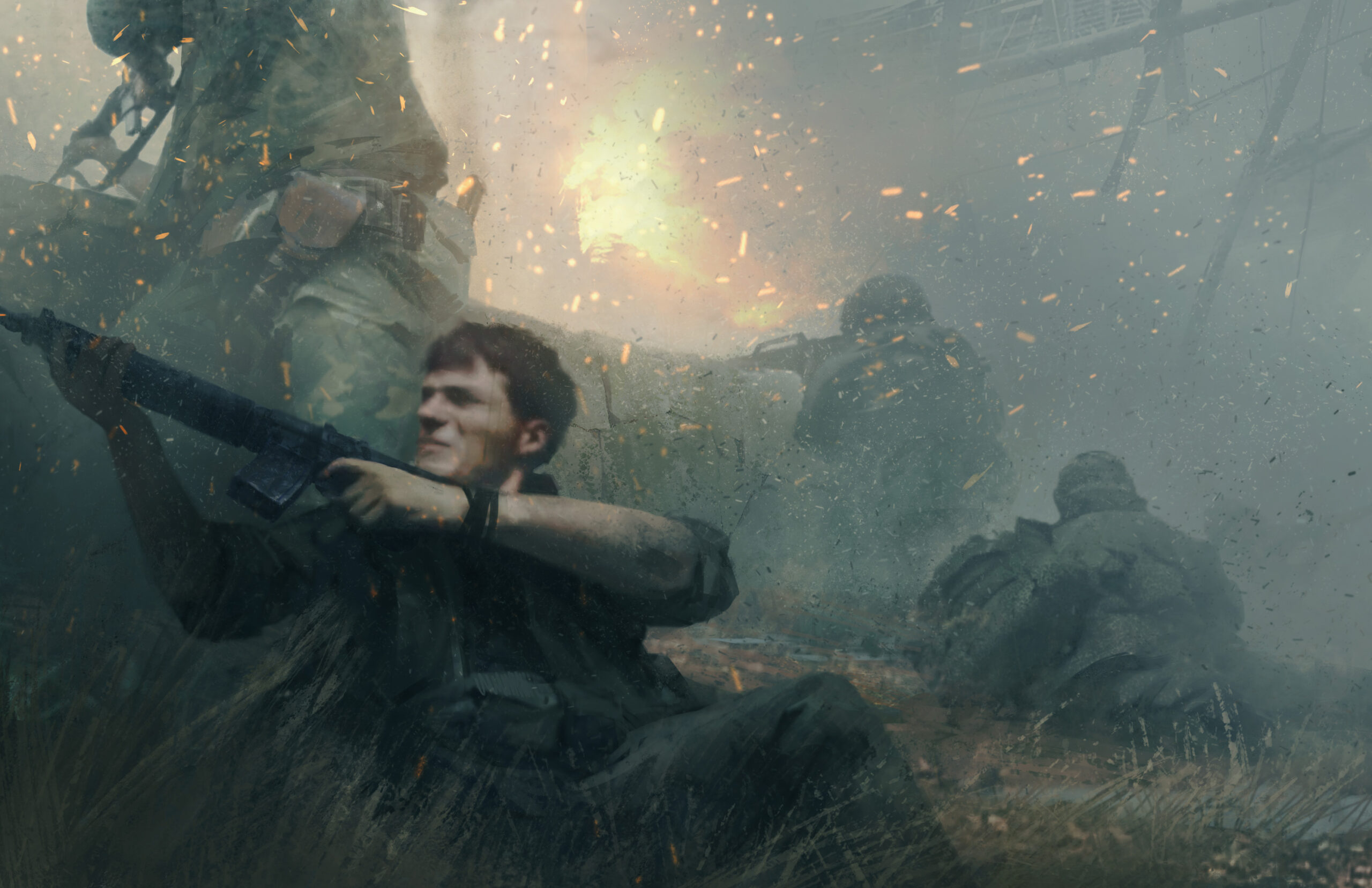A little while ago, I decided to run a tabletop roleplaying campaign for some friends. Specifically, 'Modern War', by Zozer Games, which is a "a complete squad-level game that opens up roleplaying for a wide-range of modern military-themed settings." [quote from the DriveThruRPG page, including emphasis]. I'm not the biggest fan of the Traveller system it's built on (Cepheus), but I do enjoy running military RPGs from time to time, and as there are relatively few in a modern setting, my group was interested, so in we dived...
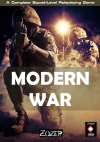
Now, I should say that this really isn't a proper 'review'. Mostly because I did not run the system the way it was intended, and some of my critique will be subjective. But to the 'not as intended point' - I made two very significant changes. The first was that I shifted the setting to World War 2. That is still a 'modern war', in most historical senses (we see combined arms, ELINT, radio communications, etc.) though obviously the noticeable difference 'at the pointy end' (where the players are) is the lack of fully automatic rifles for the infantry and the lack of ATGMs. However, a conversion tool exists to give any weapon stats in the game in a fairly straightforward manner, so without too much work I had Lee-Enfields and Thompsons, MP40s and so on. It was also set in a fantasy world so I brought in the 'magic' system from Traveller, which everyone then forgot about, but it wasn't 'actual' WW2 - this wasn't a serious simulation game, we mostly wanted to have some fun in a WW2 style setting. The intricacies of what battlefield or strategic precognitive powers entail were not covered! So all of the following was experienced through an additional layer of WW2 paint that did affect the core gameplay - keep that in mind.
As a quick primer, while this is aimed at people already familiar with roleplaying games to some extent, the general premise is that you have a group in which one person (in this case, me) is the 'game master' (abbreviated to GM) who is 'in charge' - they narrate the world, are responsible for saying how the world reacts to things, what's happening... basically everything except the individual characters played by the remaining players. Each of these players creates a 'player character' (abbreviated to PC) who then interacts with the world the GM makes. In this context, all the PCs were soldiers in an army - in a recon unit specifically, as that gave them a reasonable level of independence that they wouldn't have as low-ranking NCOs that are part of an infantry company.
The system is "2d6+attribute+skill" system. That is, when you want to do something, you find the appropriate attribute in question (Strength, Intelligence, Education, etc.) which has a numerical modifier associated with it. You then find the appropriate skill, which also has a numerical modifier associated with it, and then add that to the attribute modifier, along with any situational modifiers (also expressed as numbers, positive or negative) and then you roll two six-sided dice and add the total modifier to it. Higher is good, with most 'normal' tests needing somewhere between a 7 and a 9 total to succeed. I like this, as the random element (the two six-sided dice, abbreviated 2d6) is normally distributed - the most common result is a 7, in the middle, and the more extreme values are correspondingly rare (there's only a 1/36 chance of rolling a 2, while there's a 6/36 chance of rolling a 7).
Most of the game uses 2d6+attribute+skill rolls to determine whether the player characters succeed at what they do, be it shooting at an enemy, clambering over a fence, or smooth-talking the the logistics guy into 'losing' some supplies. Each character has randomly-rolled characteristics, while they have some say in their pick of skills - this means you can be pigeonholed into certain roles by your characteristics (if you've got poor education then I'm afraid you'll never be a particularly good medic), though the game does take some mercy on characters by setting some characteristics to a base value of 6 (which is bad, but not awful) so that you're not utterly useless when you need to dg o some pretty core things like running around carrying heavy gear. To give an example of how this all works in practice, if you wanted to clamber over a wall, you'd take your Strength characteristic modifier (let's say a -1, as you're not particularly "buff"), along with your athletics skill (let's say a +2, as you do train hard to make up for your generally weak build), and let's say the conditions are fine so there are no penalties (if it's raining then there might be a -1 or -2 modifier on top!) then the total modifier is a +1. You roll 2d6, getting a 7 (very average) and the +1 modifier makes that an 8. That's enough, the GM judges, to scramble over the wall in good time without hurting yourself - both things that could change if you'd rolled poorly.
As a core system, there are some oddities - it's sometimes hard to decide whether something is 'education' or 'intelligence'; I generally went with education being something you have to learn in an at least semi-formal setting (so medicine, for example) while intelligence is something you could reasonably 'intuit' and have learned through doing. There is a massive overlap, and I did work character elements into it - so one character had grown up in a rural setting, where they lived and breathed the countryside, so I let them use intelligence for their navigation rolls as it's something that they'd intuited a lot of the time. The team leader, however, hadn't grown up in that environment, and had been taught navigation as part of their training, so they used education. It's open to abuse, but I wasn't too worried about that as it encouraged character development.
All of this is very standard for tabletop roleplaying games - I could name a dozen systems with basically the same setup. What makes Modern War interesting, and what caught my attention, was it's promise that it contained "combat rules that factor in area fire and the inability to see your foe". For context, in most games, while the GM can keep some things secret (so a goblin is hiding in a cupboard to leap out and stab the adventurers), generally once you get into combat you can see things clearly. There are tokens on the map for where you are, where the enemy are, and when you decide to attack an enemy you roll against a set difficulty and if you succeed then you hit the enemy and do however much damage to them that your weapon does. In the traditional Dungeons and Dragons game, where you're stabbing each other with swords and spears, that works fine, but as soon as semi-automatic weapons come into play and you get things like 'suppression' it becomes unsatisfactory to just have a binary 'hit' / 'miss' in a clearly defined environment. Admittedly most systems still do that, but that's why Modern War's promise interested me.
Modern War still uses that system; it's called "aimed fire", and is used when a target is clearly visible. That can be an unaware enemy moving across a field, anyone in an open area without cover to duck behind, or a tank commander sticking out the top of his vehicle. The players roll the appropriate skill for their weapon, plus their dexterity modifier and any situational modifiers, and the 2d6 for all tests, and if they roll an 8 or higher then they hit the target and roll damage. As this is WW2, that usually means they're at the very least wounded badly enough to be out of the fight, though this is where the gaps start to show in this system. I'll get onto how enemy squads are modelled later, but the brief version is that they don't have a set 'health' - the GM is supposed to decide if a hit is enough to make them a casualty, or if they can keep fighting. I improvised a damage threshold and tracked wounded counts in enemy squads, but that's not explicitly stated.
The other method, and the one we've all been waiting for, is what's called "area fire". Once the lead is in the air then the assumption is that everyone is scrambling for the nearest cover, so you'll rapidly lose direct sight of the enemy. You may catch glimpses of movement, but as they have a substantial incentive to stay out of sight it becomes something of a guessing game of where the enemy are. When you shoot at an area you think the enemy are taking cover in, you roll to hit with all the normal modifiers in the "aimed fire" section, but if you succeed you add a single six-sided die to the 'area fire pool'. Once all the player characters have done their shooting, the area fire pool for a given area is rolled in secret by the GM; any die that comes up a 6 has just killed an enemy taking cover in that area (assuming there is one - obviously area fire into clear terrain does nothing!) Various weapons add additional dice to the pool, and this is where the smaller number of automatic weapons does hurt - being able to put a 10-round burst into a suspicious patch of foliage is much more likely to deliver results than a few Lee-Enfield shots. Which is fairly realistic, so I liked how it worked, but it's something to keep in mind for the WW2 settings. I did help them by giving them a two-inch mortar, rifle grenades, and an armoured car with an MG on it, so it wasn't an insurmountable problem (and after finding out the rate of fire of an MG34, the players immediately looted one after their first firefight).
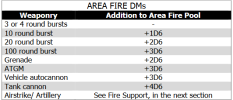
The main complication in running this is that the GM needs to keep track of a lot of moving parts, about half of which are 'secret' from the players, and if done properly the GM should try and model the uncertainty of the enemy squads as well (so they should get confused, shoot up random bits of empty terrain, and so on) all on top of adapting to deal with whatever 'clever' ideas the players have ("You want to use your MG... to shoot a tree's trunk through so that it falls on the panzer?! Um... right..."). Now, I was using the online tabletop Roll20, which does have a secret 'GM layer' that I could move the enemy squads around on, and then I manually generated Combat Mission-style contact markers on the visible layers so the players could track where they last saw an enemy.
The enemy use a similar mechanic - they roll 2d6 and only hit a player on a 12, but get bonuses based on what the players do (running around in the open, for example, gives a substantial bonus) and what weapons the enemy squad uses (getting a +1 bonus each from using grenades or a squad automatic weapon like the MG34). This is another area the system feels somewhat underprepared - in theory an enemy squad can be a nebulous thing, an enemy force who don't need any stats to say how well they fight, but then it gives bonuses based on what equipment they have - so when the players manage to kill one of them, should it be the one with the MG? That has a meaningful effect on how dangerous the squad is. In the end, as they were fighting the 'Germans', I ended up using the same squad setup and 'fully modelling them', tracking which had which weapon - I gave them an MG34 and a rifle-grenade per squad, so if they stuck together they'd have a + to attack with a unit size of 8, or if they split up then it would be two +1 to attack units of size 4. Obviously one could pick from many historical (or in my case, pseudo-historical) formations and model them exactly, and the system would support it.
One final modification of my own was the 'redshirt' system. I borrowed it from 'Patrol', a Vietnam war roleplaying game (one I've not run as mechanically it looks like a real pain, but which had some interesting ideas about how to represent the players gradually going more and more... troubled... as they spent time in 'Nam. At some point I must bounce that off someone with more knowledge of stress and trauma, as 'gamifying' it is a delicate topic. But I digress). In Patrol, you have friendly non-player squad characters with you (as the players in Modern War do) and if you ever take a hit that seriously hurts or kills your character (or that you just don't want to take) then you can choose for one of these nearby 'redshirts' to take it instead. They die horribly as you get to be the movie star and mourn their tragic death (or sigh and chalk up another KIA next to the list of names your character has for redshirts who accompanied them, as repeatedly happened to the Bren gunner).
In the first battle this worked really quite well. The players were uncertain about where the enemy were (I had them roll the 'recon' skill to spot enemy squads, giving larger bonuses as the enemy did more obvious things like shooting and moving) and were advancing through the fog of war genuinely afraid an enemy squad might jump out of the bushes and gun them down. There were a couple of hits on the squad, they struggled to really put effective fire on the enemy until the squad leader charged the enemy with their SMG and proceeded to kill two with the shooting and kill a third in close combat (the fourth choosing to surrender after that sudden display of extreme violence). The 'problem' set in when this proved the formula for many more combat encounters; they'd lay down suppressing fire - modelled as 'area fire', but I had to judge by myself how 'suppressed' and distracted by it the enemy were by it, then the squad leader would charge in and show just why a close-range SMG is such a scary weapon when everyone else has bolt-action rifles. This would occasionally go wrong, resulting in a wounded squad leader dragging their redshirt back to the medic after taking several bullets, and as I varied the scenarios (being ambushed by an armoured car while scouting bridges, coming across a panzer 2 team dismounted from their tank, ambushing an enemy convoy, being ambushed in a village) some of the players enjoyed the modest differences this resulted in, but others started to lament the lack of additional depth to the system.
In the end, I stopped running it after ten or so sessions. The out-of-combat sections were good fun, but not supported very well by the mechanics (as players use the weight of their equipment to determine what they can bring into combat, there isn't really a currency system or much incentive to try and get additional gear - I could have done more to limit their access to gear, and when it came to mortars and an armoured car, I did make them work to get the, but the system didn't offer me anything to help me run this). Likewise I couldn't find any mechanic in the rules for character advancement - no way to learn and get better, so I improvised one myself (Traveller, the system this is based on, uses the lengthy periods of time travelling through space as a 'currency' to learn new things, which you could also do, but would mean characters learn the most on slow and stable fronts where they get months off the line, while they don't learn anything in a couple of weeks of intensive operations). I think there is a promising mechanic here, in the area fire rules, but the rest of the system is somewhat basic and lacks the maturity one sees in other more tested systems. I think if you like the wargaming side of RPGs then this could be a fun experience - if what you want is a Modern War then this might still be my go-to, but when there's another system called Hostile which uses the same area fire mechanic in a sci-fi future setting and so would work much better with ripping elements straight from the Traveller rulebook as needed - and if there's one thing Traveller has in excess of it's rules for every occasion!
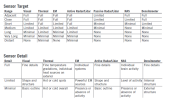
I personally quite like fairly loose and flexible systems, but Modern War leaves too many gaps that are unhelpfully ambiguous, rather than intentionally so to give me (the GM) freedom about how to fill them. Still, about half of my players enjoyed it, and only one really disliked it. I enjoyed some of the interesting situations caused by the fog of war, but I really had to work for them as a GM.
As a final note, while I did say the WW2 setting could be a problem, they recently released a supplement for the rules for warfare in Europe in 1944. I didn't buy it, so I haven't checked how 'right' I got my conversions (I bet they're pretty accurate though - I was even looking up the max loading and towing weight of a jeep, which was probably overkill), but it shows my general principle of shoving the system into a WW2 setting is consistent with the designer's intent (impressive, given that they give an earlier range band of covered times being around 1989).
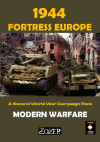
I'm curious if anyone else happens to have used it, or is considering using this system - or indeed just has some thoughts on the subsystems I've described. I'll probably never touch it again, but I will probably rip the area fire mechanics out of it and stick them in other systems if I ever want to run a game with that sort of experience.

Now, I should say that this really isn't a proper 'review'. Mostly because I did not run the system the way it was intended, and some of my critique will be subjective. But to the 'not as intended point' - I made two very significant changes. The first was that I shifted the setting to World War 2. That is still a 'modern war', in most historical senses (we see combined arms, ELINT, radio communications, etc.) though obviously the noticeable difference 'at the pointy end' (where the players are) is the lack of fully automatic rifles for the infantry and the lack of ATGMs. However, a conversion tool exists to give any weapon stats in the game in a fairly straightforward manner, so without too much work I had Lee-Enfields and Thompsons, MP40s and so on. It was also set in a fantasy world so I brought in the 'magic' system from Traveller, which everyone then forgot about, but it wasn't 'actual' WW2 - this wasn't a serious simulation game, we mostly wanted to have some fun in a WW2 style setting. The intricacies of what battlefield or strategic precognitive powers entail were not covered! So all of the following was experienced through an additional layer of WW2 paint that did affect the core gameplay - keep that in mind.
As a quick primer, while this is aimed at people already familiar with roleplaying games to some extent, the general premise is that you have a group in which one person (in this case, me) is the 'game master' (abbreviated to GM) who is 'in charge' - they narrate the world, are responsible for saying how the world reacts to things, what's happening... basically everything except the individual characters played by the remaining players. Each of these players creates a 'player character' (abbreviated to PC) who then interacts with the world the GM makes. In this context, all the PCs were soldiers in an army - in a recon unit specifically, as that gave them a reasonable level of independence that they wouldn't have as low-ranking NCOs that are part of an infantry company.
The system is "2d6+attribute+skill" system. That is, when you want to do something, you find the appropriate attribute in question (Strength, Intelligence, Education, etc.) which has a numerical modifier associated with it. You then find the appropriate skill, which also has a numerical modifier associated with it, and then add that to the attribute modifier, along with any situational modifiers (also expressed as numbers, positive or negative) and then you roll two six-sided dice and add the total modifier to it. Higher is good, with most 'normal' tests needing somewhere between a 7 and a 9 total to succeed. I like this, as the random element (the two six-sided dice, abbreviated 2d6) is normally distributed - the most common result is a 7, in the middle, and the more extreme values are correspondingly rare (there's only a 1/36 chance of rolling a 2, while there's a 6/36 chance of rolling a 7).
Most of the game uses 2d6+attribute+skill rolls to determine whether the player characters succeed at what they do, be it shooting at an enemy, clambering over a fence, or smooth-talking the the logistics guy into 'losing' some supplies. Each character has randomly-rolled characteristics, while they have some say in their pick of skills - this means you can be pigeonholed into certain roles by your characteristics (if you've got poor education then I'm afraid you'll never be a particularly good medic), though the game does take some mercy on characters by setting some characteristics to a base value of 6 (which is bad, but not awful) so that you're not utterly useless when you need to dg o some pretty core things like running around carrying heavy gear. To give an example of how this all works in practice, if you wanted to clamber over a wall, you'd take your Strength characteristic modifier (let's say a -1, as you're not particularly "buff"), along with your athletics skill (let's say a +2, as you do train hard to make up for your generally weak build), and let's say the conditions are fine so there are no penalties (if it's raining then there might be a -1 or -2 modifier on top!) then the total modifier is a +1. You roll 2d6, getting a 7 (very average) and the +1 modifier makes that an 8. That's enough, the GM judges, to scramble over the wall in good time without hurting yourself - both things that could change if you'd rolled poorly.
As a core system, there are some oddities - it's sometimes hard to decide whether something is 'education' or 'intelligence'; I generally went with education being something you have to learn in an at least semi-formal setting (so medicine, for example) while intelligence is something you could reasonably 'intuit' and have learned through doing. There is a massive overlap, and I did work character elements into it - so one character had grown up in a rural setting, where they lived and breathed the countryside, so I let them use intelligence for their navigation rolls as it's something that they'd intuited a lot of the time. The team leader, however, hadn't grown up in that environment, and had been taught navigation as part of their training, so they used education. It's open to abuse, but I wasn't too worried about that as it encouraged character development.
All of this is very standard for tabletop roleplaying games - I could name a dozen systems with basically the same setup. What makes Modern War interesting, and what caught my attention, was it's promise that it contained "combat rules that factor in area fire and the inability to see your foe". For context, in most games, while the GM can keep some things secret (so a goblin is hiding in a cupboard to leap out and stab the adventurers), generally once you get into combat you can see things clearly. There are tokens on the map for where you are, where the enemy are, and when you decide to attack an enemy you roll against a set difficulty and if you succeed then you hit the enemy and do however much damage to them that your weapon does. In the traditional Dungeons and Dragons game, where you're stabbing each other with swords and spears, that works fine, but as soon as semi-automatic weapons come into play and you get things like 'suppression' it becomes unsatisfactory to just have a binary 'hit' / 'miss' in a clearly defined environment. Admittedly most systems still do that, but that's why Modern War's promise interested me.
Modern War still uses that system; it's called "aimed fire", and is used when a target is clearly visible. That can be an unaware enemy moving across a field, anyone in an open area without cover to duck behind, or a tank commander sticking out the top of his vehicle. The players roll the appropriate skill for their weapon, plus their dexterity modifier and any situational modifiers, and the 2d6 for all tests, and if they roll an 8 or higher then they hit the target and roll damage. As this is WW2, that usually means they're at the very least wounded badly enough to be out of the fight, though this is where the gaps start to show in this system. I'll get onto how enemy squads are modelled later, but the brief version is that they don't have a set 'health' - the GM is supposed to decide if a hit is enough to make them a casualty, or if they can keep fighting. I improvised a damage threshold and tracked wounded counts in enemy squads, but that's not explicitly stated.
The other method, and the one we've all been waiting for, is what's called "area fire". Once the lead is in the air then the assumption is that everyone is scrambling for the nearest cover, so you'll rapidly lose direct sight of the enemy. You may catch glimpses of movement, but as they have a substantial incentive to stay out of sight it becomes something of a guessing game of where the enemy are. When you shoot at an area you think the enemy are taking cover in, you roll to hit with all the normal modifiers in the "aimed fire" section, but if you succeed you add a single six-sided die to the 'area fire pool'. Once all the player characters have done their shooting, the area fire pool for a given area is rolled in secret by the GM; any die that comes up a 6 has just killed an enemy taking cover in that area (assuming there is one - obviously area fire into clear terrain does nothing!) Various weapons add additional dice to the pool, and this is where the smaller number of automatic weapons does hurt - being able to put a 10-round burst into a suspicious patch of foliage is much more likely to deliver results than a few Lee-Enfield shots. Which is fairly realistic, so I liked how it worked, but it's something to keep in mind for the WW2 settings. I did help them by giving them a two-inch mortar, rifle grenades, and an armoured car with an MG on it, so it wasn't an insurmountable problem (and after finding out the rate of fire of an MG34, the players immediately looted one after their first firefight).

The main complication in running this is that the GM needs to keep track of a lot of moving parts, about half of which are 'secret' from the players, and if done properly the GM should try and model the uncertainty of the enemy squads as well (so they should get confused, shoot up random bits of empty terrain, and so on) all on top of adapting to deal with whatever 'clever' ideas the players have ("You want to use your MG... to shoot a tree's trunk through so that it falls on the panzer?! Um... right..."). Now, I was using the online tabletop Roll20, which does have a secret 'GM layer' that I could move the enemy squads around on, and then I manually generated Combat Mission-style contact markers on the visible layers so the players could track where they last saw an enemy.
The enemy use a similar mechanic - they roll 2d6 and only hit a player on a 12, but get bonuses based on what the players do (running around in the open, for example, gives a substantial bonus) and what weapons the enemy squad uses (getting a +1 bonus each from using grenades or a squad automatic weapon like the MG34). This is another area the system feels somewhat underprepared - in theory an enemy squad can be a nebulous thing, an enemy force who don't need any stats to say how well they fight, but then it gives bonuses based on what equipment they have - so when the players manage to kill one of them, should it be the one with the MG? That has a meaningful effect on how dangerous the squad is. In the end, as they were fighting the 'Germans', I ended up using the same squad setup and 'fully modelling them', tracking which had which weapon - I gave them an MG34 and a rifle-grenade per squad, so if they stuck together they'd have a + to attack with a unit size of 8, or if they split up then it would be two +1 to attack units of size 4. Obviously one could pick from many historical (or in my case, pseudo-historical) formations and model them exactly, and the system would support it.
One final modification of my own was the 'redshirt' system. I borrowed it from 'Patrol', a Vietnam war roleplaying game (one I've not run as mechanically it looks like a real pain, but which had some interesting ideas about how to represent the players gradually going more and more... troubled... as they spent time in 'Nam. At some point I must bounce that off someone with more knowledge of stress and trauma, as 'gamifying' it is a delicate topic. But I digress). In Patrol, you have friendly non-player squad characters with you (as the players in Modern War do) and if you ever take a hit that seriously hurts or kills your character (or that you just don't want to take) then you can choose for one of these nearby 'redshirts' to take it instead. They die horribly as you get to be the movie star and mourn their tragic death (or sigh and chalk up another KIA next to the list of names your character has for redshirts who accompanied them, as repeatedly happened to the Bren gunner).
In the first battle this worked really quite well. The players were uncertain about where the enemy were (I had them roll the 'recon' skill to spot enemy squads, giving larger bonuses as the enemy did more obvious things like shooting and moving) and were advancing through the fog of war genuinely afraid an enemy squad might jump out of the bushes and gun them down. There were a couple of hits on the squad, they struggled to really put effective fire on the enemy until the squad leader charged the enemy with their SMG and proceeded to kill two with the shooting and kill a third in close combat (the fourth choosing to surrender after that sudden display of extreme violence). The 'problem' set in when this proved the formula for many more combat encounters; they'd lay down suppressing fire - modelled as 'area fire', but I had to judge by myself how 'suppressed' and distracted by it the enemy were by it, then the squad leader would charge in and show just why a close-range SMG is such a scary weapon when everyone else has bolt-action rifles. This would occasionally go wrong, resulting in a wounded squad leader dragging their redshirt back to the medic after taking several bullets, and as I varied the scenarios (being ambushed by an armoured car while scouting bridges, coming across a panzer 2 team dismounted from their tank, ambushing an enemy convoy, being ambushed in a village) some of the players enjoyed the modest differences this resulted in, but others started to lament the lack of additional depth to the system.
In the end, I stopped running it after ten or so sessions. The out-of-combat sections were good fun, but not supported very well by the mechanics (as players use the weight of their equipment to determine what they can bring into combat, there isn't really a currency system or much incentive to try and get additional gear - I could have done more to limit their access to gear, and when it came to mortars and an armoured car, I did make them work to get the, but the system didn't offer me anything to help me run this). Likewise I couldn't find any mechanic in the rules for character advancement - no way to learn and get better, so I improvised one myself (Traveller, the system this is based on, uses the lengthy periods of time travelling through space as a 'currency' to learn new things, which you could also do, but would mean characters learn the most on slow and stable fronts where they get months off the line, while they don't learn anything in a couple of weeks of intensive operations). I think there is a promising mechanic here, in the area fire rules, but the rest of the system is somewhat basic and lacks the maturity one sees in other more tested systems. I think if you like the wargaming side of RPGs then this could be a fun experience - if what you want is a Modern War then this might still be my go-to, but when there's another system called Hostile which uses the same area fire mechanic in a sci-fi future setting and so would work much better with ripping elements straight from the Traveller rulebook as needed - and if there's one thing Traveller has in excess of it's rules for every occasion!

I personally quite like fairly loose and flexible systems, but Modern War leaves too many gaps that are unhelpfully ambiguous, rather than intentionally so to give me (the GM) freedom about how to fill them. Still, about half of my players enjoyed it, and only one really disliked it. I enjoyed some of the interesting situations caused by the fog of war, but I really had to work for them as a GM.
As a final note, while I did say the WW2 setting could be a problem, they recently released a supplement for the rules for warfare in Europe in 1944. I didn't buy it, so I haven't checked how 'right' I got my conversions (I bet they're pretty accurate though - I was even looking up the max loading and towing weight of a jeep, which was probably overkill), but it shows my general principle of shoving the system into a WW2 setting is consistent with the designer's intent (impressive, given that they give an earlier range band of covered times being around 1989).

I'm curious if anyone else happens to have used it, or is considering using this system - or indeed just has some thoughts on the subsystems I've described. I'll probably never touch it again, but I will probably rip the area fire mechanics out of it and stick them in other systems if I ever want to run a game with that sort of experience.
Last edited:






























































































